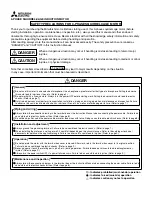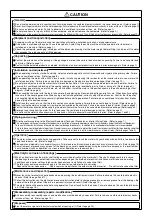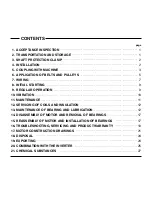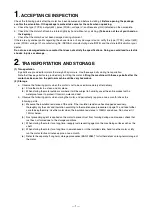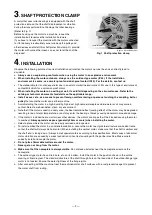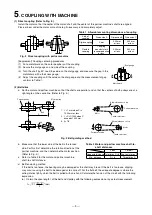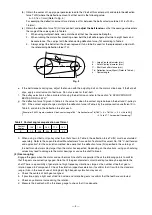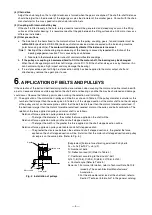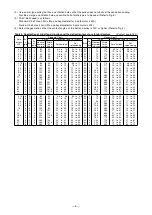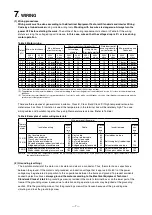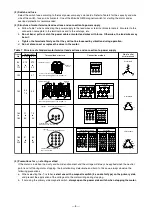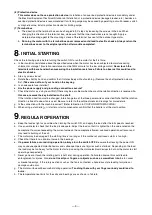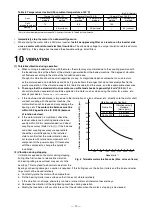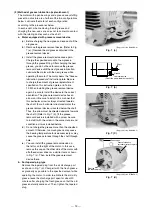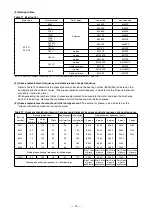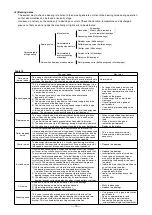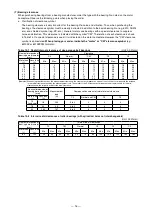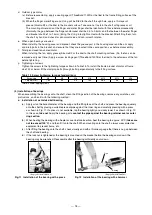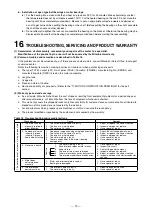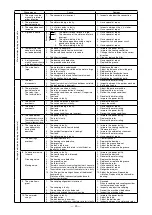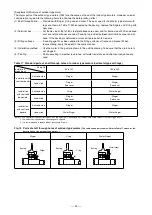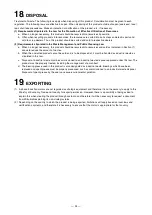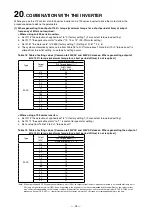
– 11 –
11
. MAINTENANCE
The quality of maintenance will greatly affect the motor life.
(1) Inspection and maintenance schedule
a. Motors used periodically, such as emergency motors absorb moisture as the stop time is long. This causes the
insulation resistance to drop. Thus, daily caution is important.
b. Motors used continuously, such as for pumps and fans, require frequent overhauling and inspection.
c. Recording of daily inspection, monthly inspections and disassembly inspections is helpful for future
maintenance.
d. Refer to Table 9 for the overhaul and inspection intervals.
Table 9 Overhaul and inspection intervals
Frequency of use
Installation location
Used infrequently
Continuously used
Dusty environment
Once every 1 to 2 years
Once in two years
Clean environment
Once every 2 to 3 years
Once every 3 to 5 years
(2) Daily inspections
a. Noise ………………… Prepare a sounding rod and listen to the noise from each motor section. Abnormal noise
such as magnetic noise, mechanical noise, mechanical friction noise and bearing noise
can be detected.
b. Odors ………………… Accidents can be sensed by a smell of varnish burning when the motor overheats due to
overloads or blocked ventilation.
c. Appearance ………… Check for oil leak, and check that the ventilation paths are not blocked. If oil is leaking,
the vibration may be significant. Check the vibration. (In operating environment with large
vibration, oil separated from excessive grease in the bearings may leak to the outside.)
Wipe away oil with waste cloth. If the bearing temperature is high, check the load (current
value). However, a slight leak of grease may not be a problem for bearings that require
lubrication as long as the temperature does not rise excessively. Even in the case of
shielded bearings, an insignificant amount of separated oil may leak at the initial stage,
but this will not affect the operation.
Touching any part of the bearings or frame to
check the temperature is dangerous. Use a temperature measuring device, such
as an alcohol thermometer.
(3) Monthly inspections
a. Deterioration or consumption of grease
………… Replenish or replace the grease according to the maintenance schedule. (Refer to 13-(4)(5).)
b. Check that the insulation resistance is above the specified value. (1M
Ω
or higher for the low voltage motor.)
Do not touch the terminals with bare hands when measuring. Doing so could lead to electric shocks.
c. Surface painting
………… Rust will form easily if the paint is peeled. Always repair the paint.
d. Dust contamination on inlet and outlet ports
………… Remove the dust from the inlet and outlet ports. Otherwise, insufficient cooling could
cause excessive heat buildup.
(4) Inspections and cleaning during disassembly
Check the operation state and make records before starting the overhaul. Use these records when restarting
operation after the overhaul.
a. Bearings …………… Remove dust and foreign matter from the bearings and bearing housing. Remove the old
grease and charge them with fresh grease. As for the amount of grease, follow the "Initial
charge amount" indicated on the "Grease lubrication procedure" instruction plate or Table
12. When shielded bearings are used, replace the bearings. Check the fitting between
the shaft and the bearings (normally k5) and the fitting between the bearings and the
bearing housing of the bracket (normally H6). If worn out or out of tolerance, replace the
concerned parts or repair those parts by such a method as metal spraying.
b. Coils and insulation … Check the wiring for looseness in the straps, and for adherence of dirt. Clean as required.
c. Other sections ……… Inspect the other sections and repair or replace the damaged parts. Clean any
contaminated parts.
d. Painting ……………… Repaint the motor if possible even if the paint is not peeling.

